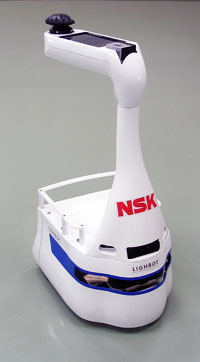
NSK Ltd. (NSK; Headquarters: Tokyo, Japan; President and CEO: Toshihiro Uchiyama) today announced that it has developed improvements for its guide robot that is equipped with indoor navigation and obstacle avoidance by adding new features that make it safer and more convenient than ever. NSK worked in cooperation with the Kanagawa Rehabilitation Center (Atsugi, Kanagawa Prefecture) in a nearly real usage environment to perform about a half a year’s worth of demonstration testing for its obstacle-avoidance, navigation-equipped guide robot in fiscal 2014. This newly developed robot is an improved product that reflects the lessons learned during that testing.
NSK will exhibit this robot at the International Robot Exhibition 2015 to be held at Tokyo Big Sight (Koto-ku, Tokyo) from Wednesday, December 2 to Saturday, December 5.
NSK is currently engaged in further improvements of the reliability of this robot, for practical application slated for the fall of 2016.
